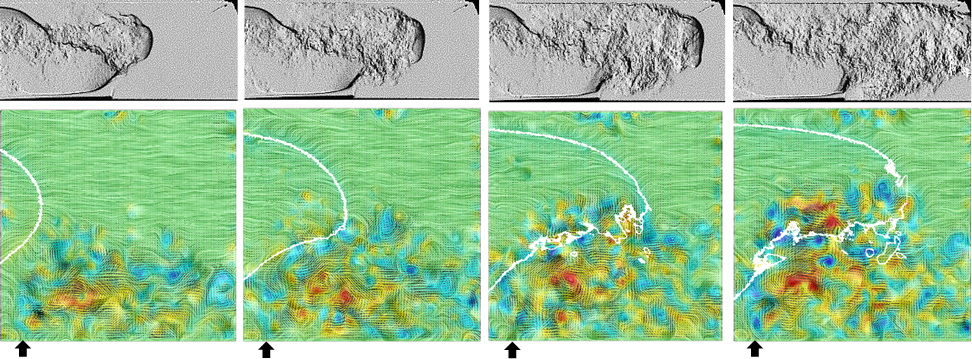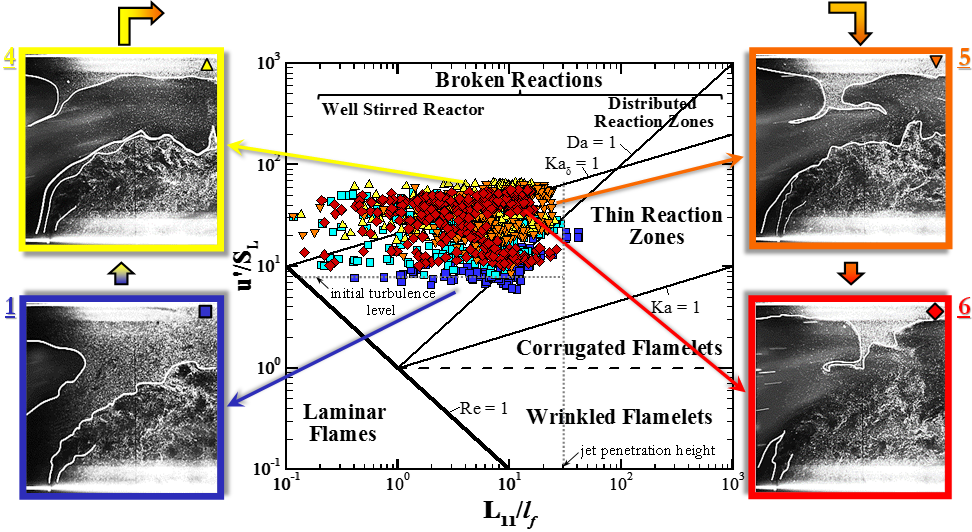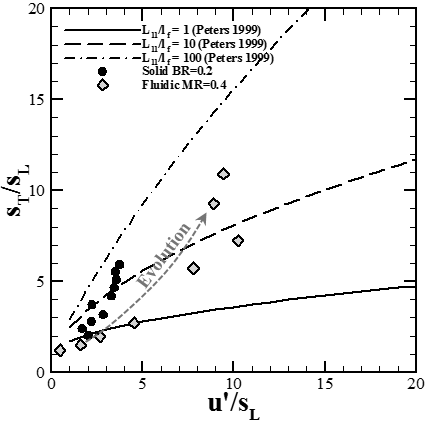Reports: DNI954753-DNI9: Interaction Physics of Deflagrated Methane Flame with Fluidic Flow for Pressure Gain Combustion
Kareem A. Ahmed, PhD, University of Central Florida
The fundamental mechanism for achieving detonation is turbulent flame acceleration from deflagration-to-detonation. The process involves generation of high flow turbulence intensities and length scales for effective flame acceleration and propagation. A transverse fluidic jet is an effective turbulence generation mechanism for flame acceleration. Turbulence generation is critical to flame acceleration and propagation. High turbulence fluctuation intensities are produced for the fluidic jet. Furthermore, the fluidic jet generated large integral length scales. These large scales produce highly turbulent flames which enhance burning rates and consequently higher turbulent burning velocities.
Our investigation under the ACS-PRF grant investigated the turbulent flame-flow interactions of highly turbulent deflagrated flames. The investigation is targeted towards turbulent flame acceleration from deflagration-to-detonation. The propagating turbulent flame experienced intense reactions due to high turbulent transport. Figure 1 shows the high-speed flame interaction with the fluidic turbulent jet. Turbulent heat and mass transfer is transported by the fluidic jet to the local reactions resulting in intensified flame burning rates and local turbulent explosions.
Fig 1: Turbulent flame interaction with high turbulent intensity field
The research focused on experimentally investigating the flame-fluidics interaction at various turbulent flame regimes. Initially, laminar flame interaction with the fluidic jet was explored to identify the main key mechanisms. The exploration further expanded the interaction study to wrinkled/corrugated, thin reaction and broken reaction turbulent flame regimes. The temporal evolution of the deflagrated flame has been characterized through the various turbulent transition modes on the turbulent flame regime diagram. Time-resolved flowfield (T-PIV) and flame (PLIF) measurements were used for the flow-flame analysis. The turbulent velocity was computed using a spatial average and quadratic mean of the fluctuating velocity from a 4 x 4 grid. The integral length scale was attained using a spatial integral of the cross-correlation of the turbulent velocity as shown in Equation (1). The turbulent velocity and integral length scale was then extracted along the propagating flame. The extracted data of the flame evolution is plotted on the turbulent flame regime diagram.
Figure 2 shows the flame regime temporal evolution starting from the laminar through the corrugated flamelets zone and further in to the thin reaction zone with peaks in the broken reaction zone. It is interesting to note the significant flame-turbulence interactions through the flame evolution from laminar to turbulent. The flame initially reacts with the turbulent field ahead of the jet resulting in flame corrugations. These corrugations are short lived due to the flame interacting with the intense jet turbulence significantly amplifying the flame turbulence through the thin reaction zones with peak intensities in the broken reaction regime. The turbulence intensities are slightly dampened.
Fig 2: Laminar to turbulent flame evolution
The interaction of a turbulent deflagrated flame with a high intensity turbulent field has been investigated as shown in Figure 3. A flame was formed in a turbulent field of intensities of u’/SL = 10. This produced a turbulent flame in the thin reaction zones regime. The turbulent propagating flame further interacted with the jet intense turbulence. These high turbulence intensities resulted in turbulent reactions in the broken reactions regime. It is expected the compressibility and baroclinic torque influence the turbulent flame structure and dynamics at these intense turbulent regimes.
Fig 3: Evolution of turbulent flame interaction with high turbulent intensity field
The turbulent burning velocity, sT/sL, for the flame evolution is quantified from the turbulent flame structure measurements, i.e., flame surface area ratio. Figure 4 shows the evolution of the turbulent burning velocities (sT/sL) relative to the turbulent intensities (u'/sL) for both interaction modes. Higher burning velocities are experienc ed by the jet flame-turbulence interaction relative to the obstacle.
Figure 4: Turbulent burning velocity
The PI tremendously appreciates the ACS PRF DNI grant. The research on this grant had and continues to have a profound influence on the PI’s research career portfolio. The PI have been awarded an AFOSR grant to heavily leverage the current ACS-PRF project and substantially extend its impact by exploring the compressibility effect in the turbulent flame regime spectrum from low compressible deflagrated flames to highly turbulent compressible detonation flames. Additionally, four students benefited from this research and received their degrees (M.S. and B.S. Honors in Major Thesis) under this research with the continuation to PhD on this research. Numerous publications [1-8] have been achieved from the research including an American Physics Society – Division of Fluid Dynamics, 2015 Gallery of Fluid Motion. This ACS DNI grant augmented the PI’s career and can be considered an overwhelming success.
















